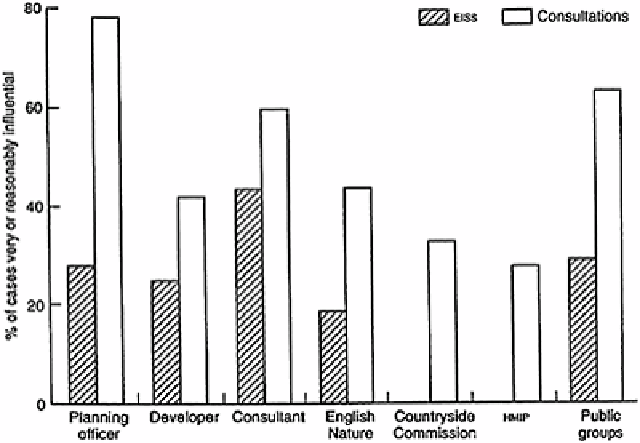Environmental Engineering Reference
In-Depth Information
Early surveys of local planning officers (Kobus & Lee 1993, Lee et al. 1994)
suggested that EISs were important in the decision in about half of the cases. Interviews
with a wider range of interest groups (DoE 1996) found that about 20 per cent of
respondents felt that the EIS had “much” influence on the decision, more than 50 per cent
felt that it had “some” influence, and the remaining 20-30 per cent felt that it had little or
no influence. Jones (1995) found that about one-third of planning officers, developers and
public interest groups felt that the EIS influenced the decision, compared with almost half
of environmental consultants and only a very small proportion of consultees. For
planning decisions, it is the members of the planning committees who make the final
decision. Interviews suggest that they are not generally interested in reading the EIS, but
instead rely on the officer's report to summarize the main issues (DoE 1996). According
to Wood & Jones (1997), planning committees followed officers' recommendations in 97
per cent of the cases they studied.
The consultations related to the EIS are generally seen to be at least as important as
the EIS itself (Jones 1995, Kobus & Lee 1993, Lee et al. 1994, Wood & Jones 1997).
Figure 8.5 clearly illustrates this point. On the other hand, many interviewees from non-
statutory bodies felt excluded from the decision-making process, and one national non-
statutory wildlife body complained that if the then Nature Conservancy Council or the
Countryside Commission did not object then their own objections went largely ignored
(DoE 1996).
While studies of early EISs (e.g. Kobus & Lee 1993, Lee et al. 1994) suggested that
material considerations were slightly more important than environmental considerations
in the final decision on a project's authorization, a later study
Figure 8.5
Opinions about the
influence of EISs and consultations on
decisions.

Search WWH ::

Custom Search